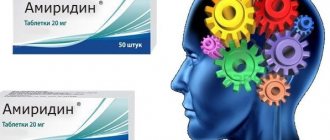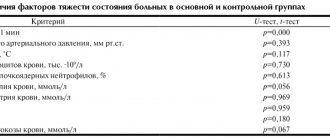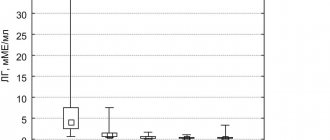Composition and release form
The drug is dispensed in the form of tablets and solution for injection.
The active ingredient is metoclopramide hydrochloride. Excipients:
- Saline.
- Acetic acid.
- Water for injections.
- Sodium sulfite.
- Edetate disodium.
Sold without a doctor's prescription. The cardboard package contains 1 bottle of clear liquid or 1-5 blisters of 10 tablets with attached instructions.
Shelf life 2 years. Optimal conditions are temperatures up to +25 C, in a dark place, away from children.
pharmachologic effect
Metoclopramide is a serotonin and dopamine receptor antagonist. It has a pronounced anti-hiccup, antiemetic and prokinetic effect. Stimulates intestinal motility in the upper section and regulates sphincter function.
The drug improves the tone of muscle contractions of the stomach, helps relax the duodenum and helps speed up the digestion process. It also has a positive effect on the functioning of the gallbladder, eliminating its disorder.
The antiemetic therapeutic effect is based on the suppression of dopamine receptors in the peripheral and central regions. Therefore, the medicine is effective in suppressing nausea and the gag reflex of various natures, namely due to anesthesia, chemotherapy, and taking certain groups of drugs when side effects occur.
The drug inhibits the effect of apomorphine, increasing the production of prolactin and increasing the content of aldosterone. Therefore, there is a temporary retention of fluid in the body.
When administered orally, the medicine is quickly absorbed into the bloodstream and reaches its maximum therapeutic effect after 1-2 hours. The overall bioavailability is 80%.
The half-life is 6 hours, in case of kidney disease it increases to 14 hours.
When the drug is administered by injection, the pharmacological effect is observed 1-3 minutes after intravenous administration and 15 minutes after intramuscular administration. Duration is 2 hours.
Interaction with other drugs
The simultaneous use of metoclopramide with levodopa or dopamine receptor agonists is contraindicated due to the existing mutual antagonism.
Alcohol enhances the sedative effect of metoclopramide.
Combinations requiring caution
Due to the prokinetic effect of metoclopramide, the absorption of some drugs may be impaired. M-anticholinergic agents and morphine derivatives have mutual antagonism with metoclopramide in terms of their effect on gastrointestinal motility.
Medicines that depress the central nervous system (morphine derivatives, tranquilizers, H1-histamine receptor blockers, antidepressants with sedative effects, barbiturates, clonidine and other drugs of these groups) can enhance the sedative effect under the influence of metoclopramide.
Metoclopramide enhances the effect of antipsychotics on extrapyramidal symptoms.
With concomitant oral use of metoclopramide and tetrabenazine, there is a possibility of dopamine deficiency, which may be accompanied by increased muscle stiffness or spasm, difficulty speaking or swallowing, anxiety, tremor, involuntary muscle movements, including facial muscles.
The use of metoclopramide with serotonergic drugs, such as selective serotonin reuptake inhibitors, increases the risk of developing serotonin syndrome (serotonin toxicity).
Metoclopramide reduces the bioavailability of digoxin. The concentration of digoxin in the blood plasma should be monitored.
Metoclopramide increases the bioavailability of cyclosporine (Cmax by 46% and exposure by 22%). It is necessary to carefully monitor the concentration of cyclosporine in the blood plasma. The clinical consequences of this interaction have not been established.
Exposure to metoclopramide increases when used concomitantly with potent inhibitors of the CYP2D6 isoenzyme. for example, fluoxetine and paroxetine. Although the clinical significance of this interaction has not been established, patients should be monitored for adverse reactions. With the concomitant use of metoclopramide with atovaquone, the concentration of atovaquone in the blood plasma is significantly reduced (about 50%).
Concomitant use of metoclopramide with atovaquone is not recommended.
With the concomitant use of metoclopramide with bromocriptine, the concentration of bromocriptine in the blood plasma increases.
Metoclopramide enhances the absorption of tetracycline from the small intestine.
Metoclopramide enhances the absorption of mexiletine and lithium.
Indications
Clinical conditions for which metoclopramide is indicated are:
- Nausea.
- Vomiting of various origins.
- Dysfunction of the digestive system.
- Atony and hypotension of the intestines and stomach.
- Postoperative gastrointestinal disorders.
- Increased gas formation.
- The period of exacerbation of ulcerative pathology of the gastrointestinal tract.
- Preparation for examination of the digestive system.
- Diseases of the biliary tract.
Contraindications
— Hypersensitivity to metoclopramide and the components of the drug;
- gastrointestinal bleeding, mechanical intestinal obstruction or perforation of the wall of the stomach and intestines, conditions in which stimulation of gastrointestinal motility poses a risk;
- confirmed or suspected pheochromocytoma due to the risk of developing severe arterial hypertension;
- tardive dyskinesia, which developed after treatment with antipsychotics or metoclopramide in history;
- epilepsy (increased frequency and severity of seizures);
- Parkinson's disease;
- simultaneous use with levodopa and dopamine receptor agonists;
- methemoglobinemia due to taking metoclopramide or a history of nicotinamide adenine dinucleotide (NADH) cytochrome b5 deficiency; - prolactinoma or prolactin-dependent tumor;
- children under 1 year of age;
- period of breastfeeding.
Carefully
When used in elderly patients;
in patients with cardiac conduction disorders (including prolongation of the QT interval), impaired water and electrolyte balance, bradycardia, taking other drugs that prolong the QT interval, arterial hypertension;
in patients with concomitant neurological diseases;
in patients taking drugs that affect the central nervous system, depression (history);
for renal failure: moderate and severe severity (creatinine clearance 15-60 ml/min), in the terminal stage (creatinine clearance less than 15 ml/min) with severe liver failure;
during pregnancy.
Use during pregnancy and breastfeeding
Pregnancy
Metoclopramide can be used during pregnancy (I-II trimesters) only if the potential benefit to the mother outweighs the potential risk to the fetus. Due to pharmacological characteristics (similar to other antipsychotics), when using metoclopramide at the end of pregnancy, the possibility of developing extrapyramidal symptoms in the newborn cannot be excluded.
Metoclopramide should not be used at the end of pregnancy (during the third trimester). When using metoclopramide, the condition of the newborn should be monitored.
Breastfeeding period
Metoclopramide is excreted in small amounts into breast milk. The possibility of adverse reactions in a child cannot be ruled out. The use of metoclopramide during breastfeeding is contraindicated. If it is necessary to use the drug during lactation, breastfeeding should be stopped.
Mode of application
Depending on the form of the drug, Metoclopramide has some application features:
- Oral method - take half an hour before meals, do not chew the tablets, be sure to wash them down with water. The maximum duration of treatment for vomiting and nausea is up to 5 days. Intervals between doses of the drug should be at least 6 hours. The dosage of the drug is calculated individually, according to age, body weight and pronounced clinical picture. Do not exceed the amount of medication above 0.5 mg/kg. The optimal adult dosage is 10 mg 3 times a day.
- Injection method - the drug is prescribed for a course of 5 days. The solution is administered intravenously or intramuscularly over 3 minutes. Dosage for adults: 10 mg once or 30 mg 3 times a day.
In childhood, the use of Metoclopramide is possible from 2 years of age. If you weigh less than 60 kg, 0.1-0.15 mg/kg of the drug is indicated three times a day. Children over 15 years old weighing more than 60 kg are prescribed 10 mg 3 times a day.
Elderly people should reduce the therapeutic dose, taking into account the deterioration of the liver and excretory system.
Patients with kidney pathologies should use the drug with caution. The dose is reduced by 75% or 50% depending on the condition.
If liver function is impaired, take 10 mg once, or reduce the dosage by half.
Buy Metoclopramide solution intravenously and intramuscularly 5mg/ml 2ml No. 10 in pharmacies
Instructions for use Metoclopramide solution IV and IM 5mg/ml 2ml No. 10 Dosage forms solution for injection 5mg/ml 2ml Synonyms Vero-Metoclopramide Metoclopramide-Akri Metoclopramide-Promed Cerucal Cerulan Group Antiemetics International nonproprietary name Metoclopramide Composition Active substance - metoclopramide. Manufacturers: Biokhimik OJSC (Russia), Moscow Endocrine Plant (Russia), Novosibkhimpharm (Russia), Polpharma Pharmaceutical Plant (Poland), Promed Exports Pvt.Ltd (India), Sotex PharmFirma (Russia) Pharmacological action Pharmacological action - antiemetic, antihiccup. Stimulates the motor activity of the upper gastrointestinal tract and normalizes its motor function. Strengthens the tone and amplitude of gastric contractions, relaxes the pyloric sphincter and duodenal bulb, increases peristalsis and accelerates gastric emptying. It is a dopamine antagonist, suppresses the central and peripheral effects of apomorphine, increases the secretion of prolactin, aldosterone levels, and tissue sensitivity to acetylcholine. It is quickly and well absorbed, the maximum concentration is reached 1-2 hours after taking a single dose. Easily passes through histohematic barriers and penetrates tissues. Excreted in the urine after 72 hours. Side effects Dry mouth, constipation or diarrhea, drowsiness, depression, extrapyramidal disorders (convulsive twitching of the facial muscles, impaired movement of the eyeballs, protruding tongue), edema, galactorrhea, hyperprolactinemia, menstrual irregularities, mucosal hyperemia nasal membranes, skin rashes. Indications for use Nausea, vomiting, functional digestive disorders, reflux esophagitis, atony and hypotension of the stomach and duodenum; preparation for diagnostic studies of the gastrointestinal tract. Contraindications Hypersensitivity, glaucoma, pheochromocytoma, epilepsy, Parkinson's disease and other extrapyramidal disorders, pregnancy (first trimester), breastfeeding (breastfeeding should be stopped during treatment). Directions for use and dosage : Inside. Adults: 5-10 mg (1-2 teaspoons of solution) 3 times a day before meals or 2 ml intramuscularly. Children - 0.5 doses for adults; newborns are prescribed in the form of drops. Overdose Symptoms: hypersomnia, disorientation, extrapyramidal disorders. Treatment: usually go away on their own within 24 hours after discontinuation of the drug; if necessary, prescribe anticholinergic and antiparkinsonian drugs. Interaction The effect of the drug can be weakened by anticholinesterase drugs. Antipsychotics increase (mutually) the likelihood of developing extrapyramidal disorders. Strengthens the sedative effect of sleeping pills and alcohol. Slows down the absorption of digoxin, accelerates the absorption of paracetamol, tetracycline, levodopa, ethanol. Special instructions The possibility of decreased concentration and increased reaction time during treatment should be taken into account (it is better to avoid driving a car and working with potentially dangerous equipment). During the treatment period, alcohol consumption is not recommended. The injection solution must not be mixed with alkaline infusion solutions. Storage conditions List B. Store at room temperature in a dry place.
Side effects
The antiemetic may cause the following side effects:
- Constipation, dry mouth, profuse diarrhea.
- Feelings of drowsiness, malaise, headache and dizziness during the initial period of therapy.
- Tension of the facial muscles.
- Symptoms of parkinsonism and dyskinesia with prolonged use.
- Hormonal imbalance.
- Allergic manifestations.
Overdose
In case of non-compliance with the therapeutic dose, an overdose is possible. It manifests itself with a pronounced clinical picture in the form of nervous disorders. Hallucinations and unclear consciousness are noted.
Rarely - deterioration of the cardiovascular system with a decrease in blood pressure, the appearance of bradycardia, even cardiac arrest.
Signs of an overdose last a day after starting to take the drug.
Treatment based on symptoms, medication with monitoring of cardiac and respiratory function.
special instructions
Caution should be exercised when using metoclopramide in elderly patients.
From the nervous system, extrapyramidal disorders may be observed, especially in children and young patients and/or when using high doses, usually developing at the beginning of treatment or after a single use. The use of the drug must be stopped immediately if extrapyramidal symptoms occur. The reactions are completely reversible after cessation of treatment, but may require symptomatic therapy (benzodiazepines in children and/or anticholinergic antiparkinsonian drugs in adults). To avoid overdose of the drug, a minimum interval of 6 hours must be observed between use, even in case of vomiting. Long-term treatment with the drug may lead to the development of tardive dyskinesia, which is potentially irreversible, especially in elderly patients. The duration of treatment should not exceed 3 months due to the risk of developing tardive dyskinesia.
If there are signs of tardive dyskinesia, treatment should be discontinued. When metoclopramide is used simultaneously with neuroleptics, as well as with metoclopramide monotherapy, neuroleptic malignant syndrome is observed. It is necessary to immediately stop treatment with the drug if symptoms of neuroleptic malignant syndrome appear and apply appropriate therapy.
Caution must be exercised when used in patients with concomitant neurological diseases and in patients taking drugs that affect the central nervous system.
When using the drug, symptoms of Parkinson's disease may also occur. Cases of methemoglobinemia have been reported, which could be caused by a deficiency of the enzyme NADH-dependent cytochrome b5 reductase. In this case, the use of the drug must be stopped immediately and completely and appropriate measures must be taken. Severe cardiovascular side effects have been reported, including vascular insufficiency, severe bradycardia, cardiac arrest, and QT prolongation.
Caution should be exercised when using the drug in elderly patients, patients with cardiac disorders (including prolongation of the QT interval), patients with fluid and electrolyte imbalance, bradycardia and in patients taking drugs that prolong the QT interval. For moderate to severe renal failure and severe hepatic failure, a dose reduction is recommended (see section "Dosage and Administration").
Effect of the drug on the ability to drive vehicles and machinery
During the treatment period, care must be taken when driving a car and engaging in potentially hazardous activities that require concentration and speed of psychomotor reactions, because use of the drug may cause drowsiness and dyskinesia.





